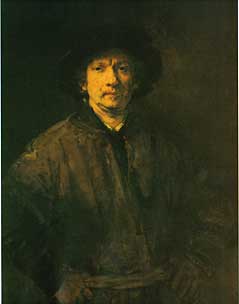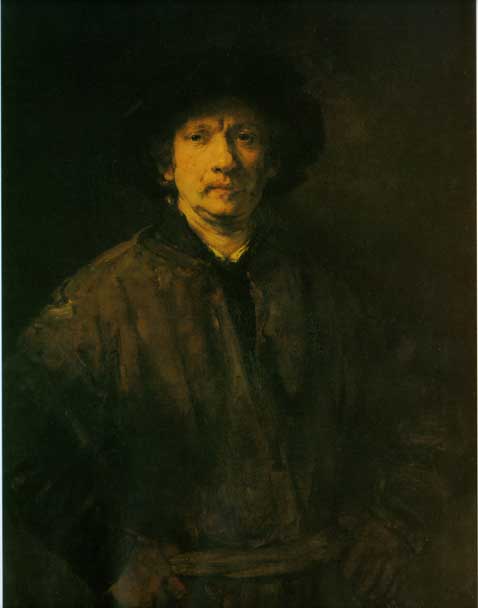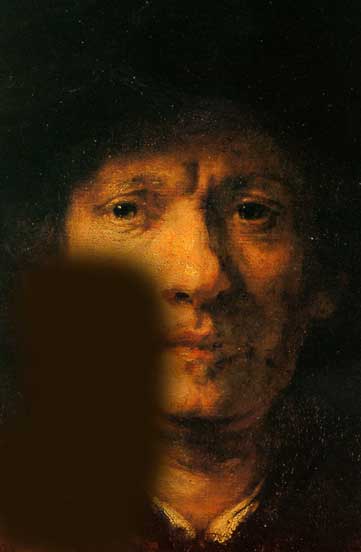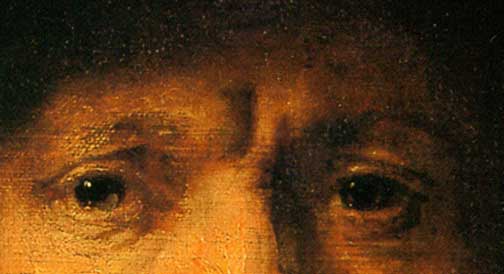
by Gerald Grow
 |
Seen from a distance, the Rembrandt "standing" self portrait in Vienna (1652) shows the bold, confident appearance that is usually attributed to it. |
 |
It shows Rembrandt in what appears to be his plain and stained painter's clothes -- but in a stance of supreme assurance. The painting seems to assert that the pure genius of this man -- and not fine clothing, wealth, or high birth -- make him a member of the only aristocracy that matters. |
 |
As you get closer to the face, the supreme self-assurance grows, along with a sense that he is secure in the power of his genius. (Here parts of the face have been masked off to elicit the expression of confidence.) But that is not all.  |
 |
Up close, we cannot see a face whole, for the eye must scan the expressive parts of the face with unconscious rapidity and assemble those quick saccadic glances into an interpretation of the whole expression. If, as your eyes scan the picture, your mind configures these parts of the face into an expression, you see something quite different from the air of self-confidence that dominates the picture from a distance. What is this new expression? |
 |
As you look closer, different expressions emerge from the face that had at first seemed so bold, so confident, so separate. 
The brash confidence melts into tenderness -- as if Rembrandt is unsettled not by anything in himself, but by what he sees in front of him. |
 |
| The left eye, that seemed so bold from a distance, up close seems almost shockingly touched by what it sees. The dark, falling diagonal line leaps from the background to weigh the eye down and push the brow in the direction of tears. | (These images have not been altered in any other way, other than to show portions of the face by cropping or masking the rest.) | And the right half of the face becomes a sadly solicitious, softly modulating expression of profound concern, an almost saintly look of sympathy, bordering on pity. |
|
When you see the eyes up close, you are caught in the contrast between their torn, touched, tender look and the boldly self-contained confidence of the whole composition seen from a distance. Scroll slowly down. Pause as the eyes on the full face come into view. Then scroll down to see the whole face. Try to keep seeing, in the full face, the expression the eyes show when seen up close.  |
 |
 |

In 1981, I visited Vienna on the unhappy occasion of the death of my wife's father. During that time, I found an inexplicable comfort in the many visits I made to this Rembrandt self-portrait in the Vienna Kunsthistorisches Museum. It drew me back again and again. Again and again, I felt nourished and renewed by the experience. It is good to revisit the portrait again, in reproductions, and recognize for the first time the source of that comfort in the "hidden" expression of empathy that forms the foundation of both Rembrandt's penetrating gaze and his confident stance.
How do we understand a painting that changes like this as we walk closer to it? From a distance, it shows Rembrandt as boldly confident, self-assured, solid -- the powerful grownup genius who outlived the brash youth of the early self-portraits. The painting has been described as having a "somewhat defiant air" that "radiates self-assurance" (Rembrandt by Himself, 190). There is no doubt about that -- from a distance. But as we come close enough to see the face, the painting changes. The confidence begins to melt. The whole face becomes less contained, less definite. The eyes show themselves to be possessed by a tremendous suggestion of pain, or the sympathetic awareness of tremendous pain in others -- or both. Up close, Rembrandt is no longer standing apart, regally looking on. He is instead deeply touched, moved, torn by what he is seeing. All his confident features melt in the direction of an immensely tender sense of empathy. It is an expression that no longer stands apart in isolated superiority. It is the expression of someone who is drawn into the lives and feelings and ventures and sufferings of all he sees. And he sees too well: His unclosing eyes stare on the verge of shock at the severity of what he sees, but a shock enveloped by a responsive, compassionate gentleness. It is as if Rembrandt pays a price for being as good as he is: The price of seeing is to see things as they are. And he must live with what he sees. The beauty and vitality and suffering and self-deception of others become his to know and to feel and to show and to heal. The bold, confident stance of separateness is only an intermediary position. Behind it, inside it, Rembrandt gives himself an expression that joins him with what is before him. He may survive through self-confidence, but he paints through empathy. As part of the painting's gentle irony, the soul he looks deeply into and feels torn with compassion by what he sees, is yours, dear viewer, as you look unsuspectingly up into the penetrating tenderness of his gaze. That helps explain how it is possible to approach this painting and suddenly feel like crying, as you have the richly unnerving experience of being seen by Rembrandt. |

Wild SpeculationWhat I'm about to say is outrageous, but it is a thought that won't go away. When you look at the expression on Rembrandt's face here, it has a familiar ring to it. We have seen this kind of face before. But where? Where have there been painted faces that look upon us and the world with a combination of great power and great tenderness, an undeniable superiority combined with the tenderest of sympathies? Where have we seen faces that seem to look into our souls and find there the innermost unexpressed privacy of our most secret sufferings, and know them, know them all, and embrace them with the broadest of understandings? Where have we seen faces that, while clearly apart from us, are yet still in some profound way joined with our deepest souls? We have seen this in the faces of Jesus, Mary, and the Saints in Catholic religious art. But wait! Rembrandt was painting in a fiercely Protestant country in a fiercely Protestant time. This was a country that had ripped such images from the churches and destroyed them as "idols." Is it remotely possible that Rembrandt has incorporated into his own image the human face of God? -- the face that sees everything and toward everything shines a tenderness born of knowing all suffering? Is is possible that Rembrandt, in some unimaginably subversive way, has hidden the florid compassion of Catholic art inside the Protestant austerity of this self-portrait? Seen up close, the painting would have no greater radiant charge to it if he suddenly parted his cloak to reveal a naked, bleeding, and compassionate heart. Is this possible? -- or is this just Rembrandt hiding, in the closest expressions of his face, the great open secret that the heart has no secrets? |